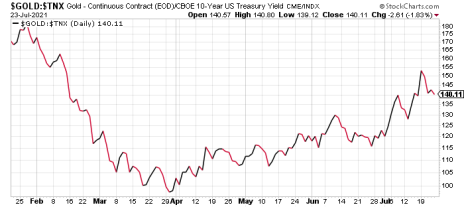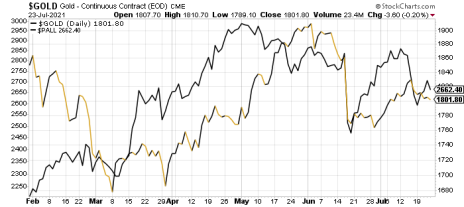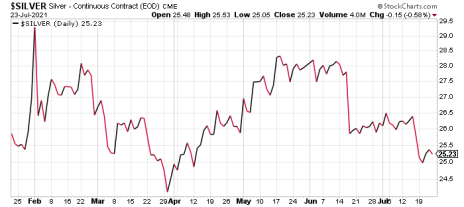Demand for gold is typically driven by its status as a safe-haven investment, and new pandemic and economic fears could prompt more people to invest in gold.
The Delta variant of the coronavirus is starting to gain currency in the U.S. media, and already there have been noises to the effect that masks and other restrictions may be reintroduced this fall, which could lead to more supply shortages—or what University of Massachusetts economics professor Arindrajit Dube calls “pandemic economics,” which could convince people to invest in gold again based on these growing fears.
Another factor that has stimulated some safety-related demand for gold is the worry that the U.S. is entering another prolonged period of “stagflation,” similar to the kind experienced in the 1970s. This was the subject of an editorial by Randall Forsyth in last week’s issue of Barron’s. Quoting former AllianceBernstein chief economist Joseph Carson, Forsyth noted that the Consumer Price Index (CPI):
“…would be rising at double-digits rates similar to those in the 1970s if the index were calculated the old way [i.e. if government statistics didn’t exclude housing prices].”
[text_ad]
Indeed, weaker growth expectations have likely been factored into the Treasury market in the form of lower yields. After peaking around 17.50 in March, the 10-year Treasury Yield Index (TNX) has fallen to a recent low of 12, which amounts to a 30% drop—by far the biggest bond yield decline since early 2020 when the pandemic panic started.
Lower bond yields are another clue that investors are becoming more risk averse and are looking to hedge equity market risk. While the U.S. dollar index remains strong due to the liquidation underway in some areas of the stock market (e.g. economically-sensitive industries like airlines, hotels and travel stocks), gold is surely coming back on investors’ radars as a potential safe haven should there be another big outbreak of the virus this fall.
Time to Invest in Gold Again
It’s my view that the fear of more restrictions (which would presumably hinder the economic recovery) has kept demand for gold fairly buoyant in recent months in spite of a strong U.S. dollar. Lower Treasury yields have meant less competition for non-yielding gold; the following graph illustrates gold’s relative outperformance versus the 10-year yield index in recent weeks.
This is one of five major factors that typically determine gold’s intermediate-term (3-6 month) direction. Another one is leadership in the white metal palladium, which tends to lead gold at key turning points. The following graph compares the gold price (gold line) with palladium (black line), and as is normally the case, palladium has provided both bullish and bearish leadership clues in the last several months. Most recently, palladium’s rally in June gave the “heads-up” signal for gold to follow suit in July.
The only key factor that is holding gold back from rallying at this point is the lack of confirmation in the silver market. As gold’s “sister” metal, silver should always lead (or else keep pace with) gold’s rallies. The fact that silver has notably lagged the yellow metal lately is a sign that gold likely isn’t quite ready to launch a sustained uptrend.
Nonetheless, the preliminary strength in palladium and lower Treasury bond yields—along with growing Delta variant worries—are key factors telling us that demand for gold may be growing and the gold price is preparing for another leg higher this fall. As always, we’ll keep a close watch on the key indicators for signs that the bulls have decisively regained control over gold’s interim trend.
For now, though, a measure of caution is still in order as we wait for all the pieces to fall into place. And as we head closer into what could be a long, dark autumn for the U.S., it’s a good time to invest in gold.
Editor’s Note: This post was excerpted from the latest issue of Sector Xpress Gold & Metals Advisor. Click here to read more.
[author_ad]




